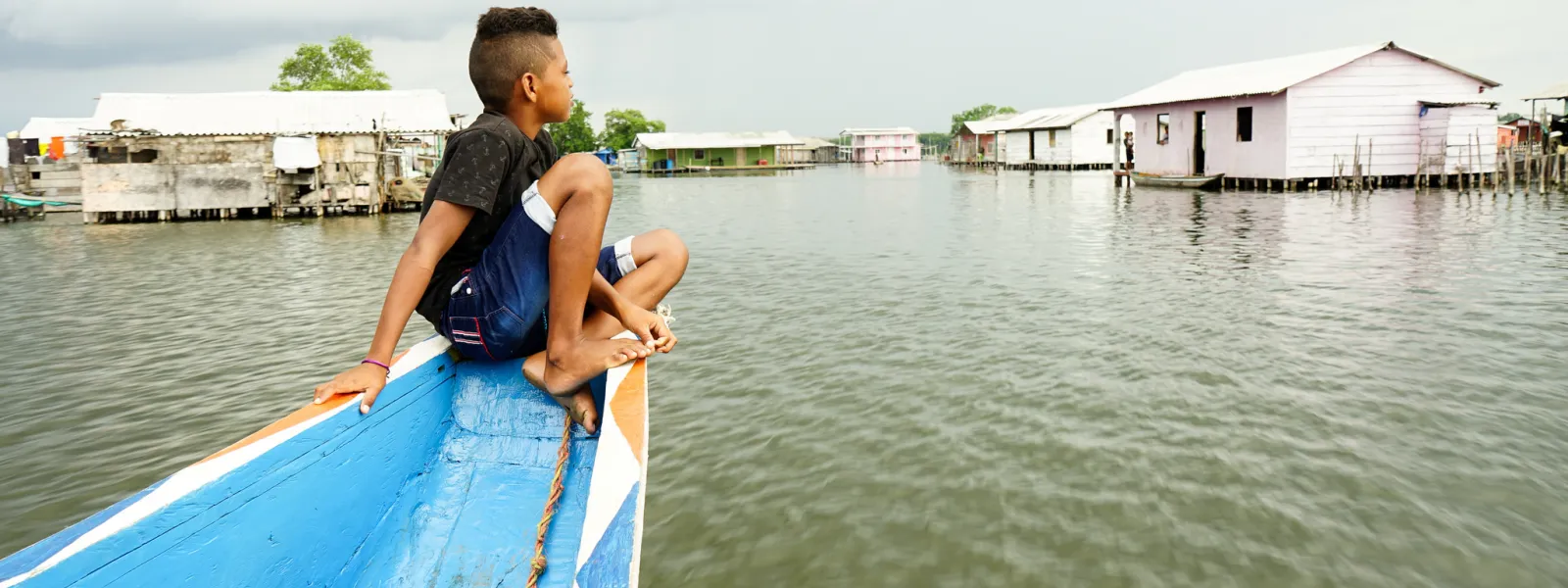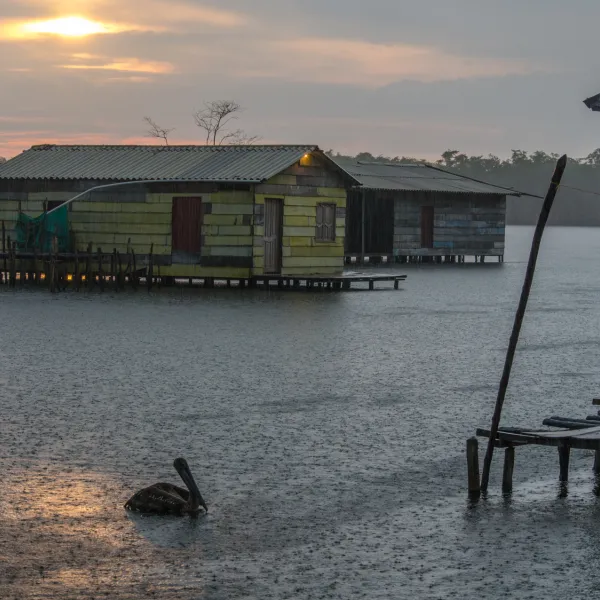
Project
Photo: Anna Laurie Miller / AIDAConserving the Ciénaga Grande de Santa Marta
Ciénaga Grande de Santa Marta, the largest and most productive coastal wetland in Colombia, covers 45,000 hectares. At the confluence of the Magdalena River and the Caribbean Sea, the site boasts an immense variety of flora and fauna, including mammals, birds and fish. Its southern tip is a beautiful sanctuary of mangroves, swamp and amphibious forest.
On the calm waters of the marsh stand the Ciénaga’s famous stilt villages, supported by pillars or simple wooden stakes and inhabited by local fishermen since 1800. In a place accessible only by water, many of the things we take for granted—being served a glass of water, quick access to a doctor—are considered luxuries. Residents depend on the natural world around them. Sadly, in recent years mass fish die-offs caused by the marsh’s degradation have threatened the livelihoods of 2,500 people who call the Ciénaga Grande home.
Illegal activities are destroying this vital ecosystem: intentionally set forest fires, deforestation of large tracks of land for agriculture and livestock, logging and burning of mangroves, and 27 kilometers of illegally built dikes.
This destruction not only devastates the local fishery; it also has global impact. Ciénaga Grande’s mangroves absorb large quantities of carbon dioxide from the atmosphere, aiding in the global fight against climate change.
The importance of the Ciénaga Grande has been recognized both nationally – the Sanctuary of Flora and Fauna Ciénaga Grande de Santa Marta is a national park – and internationally: UNESCO’s Man and the Biosphere program declared the lagoon a biosphere reserve; and the Ciénaga Grande is listed as a Wetland of International Importance under the Ramsar Convention, an intergovernmental treaty for the protection of wetlands.
AIDA and our partners are advocating for the Colombian government to fulfill its national and international obligations to protect the Ciénaga Grande. After all, millions of animals, the local community, and our global climate depend on it.
Partners:

Related projects

Coral reefs in Costa Rica: Economic Value, Threats and International Legal Commitments to Protect Them (in Spanish)
The report (in Spanish), published with financial support from Conservation International, aims to serve as a foundation for introducing specific legislation on protecting coral reefs in Costa Rica, and to support their conservation in Latin America and the Caribbean, a crucial task. In the first section, the report highlights the useful richness of the reefs. They protect cities and communities from the coastal erosion caused by hurricanes and storms (reefs absorb up to 90% of the impact of the waves). They mitigate climate change. They provide abundant fishing and valuable data for medical research (corals have been recognized as potential sources of cancer-fighting medicine). Reefs attract tourism for recreation and their beauty. And they maintain other habitats wealthy in biopersity. Reefs are nurseries, homes and meal spots for countless creatures and supply tons of seafood for our consumption. The report is backed by figures. It quantifies the economic value of a reef at more than $1 million per hectare. That equates to about $582 million for all of Costa Rica’s coral reefs. The calculation of damages to these underwater resources, however, could push that value up tenfold or more if we consider the legal actions related to reefs in countries like Belize and the United States. The report highlights the urgency of creating a legal instrument in Costa Rica to protect coral reefs for the benefit of this and future generations. Read and download the report (in Spanish)
Read moreAmidst criticism, BNDES approves unprecedented loan for controversial Belo Monte dam in Brazilian Amazon
FOR IMMEDIATE RELEASE November 29, 2012 Media Contacts: Astrid Puentes, AIDA, [email protected], +52 1-55 2301-6639 Brent Millikan, International Rivers, [email protected] +55 61 8153-7009 Maíra Irigaray, Amazon Watch, [email protected] +1 415 622-8606 Amidst criticism, BNDES approves unprecedented loan for controversial Belo Monte dam in Brazilian Amazon Financing ignores violations of human rights and environmental safeguards, tarnishing bank’s reputation, critics state Brasilia—On Monday, November 26, the Brazilian National Development Bank(BNDES) announced approval of an unprecedented loan of BRL 22.5 billion (approximately US$10.8 billion) for construction of the controversial Belo Monte dam project on the Xingu river, a major tributary of the Amazon. It is the largest loan in the bank’s 60-year history. BNDES is slated to be responsible for BRL 13.5 billion of direct finance, while Caixa Econômica Federal (CEF), a public bank, will pass through BRL 7 billion and private investment bank BTG Pactual will administer another BRL 2 billion. Responding to the BNDES announcement, nine Brazilian civil society organizations filed a petition yesterday with the Federal Public Prosecutor’s Office (Ministério Público Federal) calling for an investigation of apparent violations of legally-binding requirements related to the project’s social and environmental impacts, risks and economic viability. The petition calls on prosecutors to take urgent measures to prevent BNDES from disbursing loan proceeds to the project developer (Norte Energia, S.A.) prior to the completion of a full investigation. The controversial project has been paralyzed on at least six occasions by affected indigenous communities and fishermen, who have protested over the failures of Norte Energía and government agencies to comply with the project's mandated environmental and social provisions. Eight thousand of the project's own workers also have shut down the dam, recently setting fire to construction camps and machinery and blocking roads, in protest against violations of labor legislation. “As long as Norte Energia and the Brazilian government, including BNDES, continue to ignore demands by affected peoples, there will be resistance and increased conflict. By approving the massive loan with so much conflict on the ground shows the lack of commitment by BNDES to meet rights and environmental safeguard commitments. It should reconsider the loan approval to avoid any further conflict,” said Maira Irigaray, International Finance Advocate at Amazon Watch. Belo Monte was suspended twice in 2012 by federal judges for the lack of prior consultations with affected indigenous communities, as required by the Brazilian Constitution and international human rights agreements. The International Labor Organization and the Inter-American Commission on Human Rights (IACHR) have declared that the project places at risk the rights of affected indigenous communities. Expert and independent analysis has found that Belo Monte is economically, socially and environmentally unviable. Norte Energía and federal government agencies are facing 15 civil proceedings in the Brazilian courts lodged by the Public Ministry, the Public Defender’s Office and civil society institutions, as well as international suits that question the large number of illegalities and irregularities committed since the start of the project. Despite massive legal, financial and reputational risks surrounding Belo Monte, BNDES has decided to finance the project anyway, apparently under intense pressure from the administration of President Dilma Rousseff. By approving the loan, BNDES makes itself the main financier of a project notorious for violations of environmental legislation and human rights, including the culture integrity of indigenous and river communities. Among its environmental impacts, Belo Monte is expected to cause large emissions of greenhouse gases, including methane, a gas that is 25 times stronger than carbon dioxide. “The violations of human rights caused by the construction of the Belo Monte dam have been denounced before international organizations for which the State of Brazil and now also BNDES could be responsible,” said Astrid Puentes, Executive Co-Director of the Interamerican Association for Environmental Defense (AIDA), an organization that offers legal support to the affected communities. In 2011, the Inter-American Commission on Human Rights – IACHR, part of the Organization of American States (OAS), called for precautionary measures to protect the life, personal and cultural integrity of the contacted and uncontacted indigenous communities of the Xingu River affected by the construction of the Belo Monte dam. The Brazilian government chose to ignore the Commission’s recommendations. “No serious social and environmental safeguards were implemented by BNDES prior to the approval of this loan for Belo Monte using the money of Brazilian taxpayers” argued Antonia Melo, coordinator of the Movimento Xingu Vivo para Sempre. “BNDES claims that part of the funds will be used in the mitigation of the impacts of Belo Monte, but this is just talk. No one guarantees that this money is going to minimize the suffering of those affected. To date, virtually none of the promises made to indigenous, river people and fishermen have been met. BNDES already has transferred BRL 2.9 billion to Norte Energia without any serious risk analysis, and you can see the disastrous situation of the people in the region, the deforestation and the lack of infrastructure in Altamira.” The unprecedented BNDES loan for Belo Monte, slated to be the world’s third largest dam project, is the largest in the bank’s 60-year history. Critics charge that the project is economically unviable, due to factors such as burgeoning construction costs that increased over six fold from BRL 4.5 billion reais in 2005 to current estimated of BRL 28.9 billion. The project is expected to produce only 39% of its installed capacity of 11,233 MW capacity. According to Brent Millikan, Amazon Program Director at International Rivers, “If the true social and environmental costs, along with the financial, legal and reputational risks of Belo Monte were seriously taken into consideration, BNDES would never get near the project.” Further information: www.aida-americas.org/es/project/belomonte www.internationalrivers.org/campaigns/belo-monte-dam www.amazonwatch.org/work/let-the-river-run www.xinguvivo.org.br
Read moreBelo Monte Dam Suspended by Brazilian Appeals Court
FOR IMMEDIATE RELEASE Media Contacts: Brent Millikan, International Rivers [email protected], +55 61 8153-7009 Andrew Miller, Amazon Watch [email protected], +1 202 423 4828 Joelson Calvacante, Inter-American Association for Environmental Defense (AIDA) [email protected], +52 55 5212-0141 Belo Monte Dam Suspended by Brazilian Appeals Court Project was illegally authorized by Congress without prior consultation with indigenous tribes, judges say Altamira, Brazil: A high-level court yesterday suspended construction of the controversial Belo Monte dam project on the Amazon’s Xingu River, citing overwhelming evidence that indigenous people had not been properly consulted prior to government approval of the project. A group of judges from Brazil's Regional Federal Tribunal (TRF1) upheld an earlier decision that declared the Brazilian Congress’s authorization of the project in 2005 to be illegal. The decision concludes that the Brazilian Constitution and ILO Convention 169, to which Brazil is party, require that Congress can only authorize the use of water resources for hydroelectric projects after an independent assessment of environmental impacts and subsequent consultations with affected indigenous peoples. The ruling means that Brazilian Congress will have to correct its previous error by organizing consultations on the project’s impacts with affected indigenous peoples of the Xingu River, especially the Juruna, Arara and Xikrin tribes. Their opinions should be considered in a Congressional decision on whether to authorize Belo Monte, and in the meantime the project consortium has been ordered to suspend construction. Project consortium Norte Energia, S.A, led by the parastatal energy company Eletrobras, faces a daily fine of R$500,000, or about US$250,000, if it does not comply with the suspension. The dam consortium is expected to appeal the decision in the Brazilian Supreme Court. “The court’s decision highlights the urgent need for the Brazilian government and Congress to respect the federal constitution and international agreements on prior consultations with indigenous peoples regarding projects that put their livelihoods and territories at risk. Human rights and environmental protection cannot be subordinated to narrow business interests” stated Federal Judge Souza Prudente, who authored the ruling. “This latest court ruling vindicates what indigenous people, human rights activists and the Federal Public Prosecutor’s Office have been demanding all along. We hope that President Dilma’s Attorney General and the head judge of the federal court (TRF1) will not try to subvert this important decision, as they have done in similar situations in the past,” said Brent Millikan of International Rivers, based in Brasilia. “This decision reinforces the request made by the Inter-American Commission on Human Rights in April 2011 to suspend the project due to lack of consultations with indigenous communities. We hope that Norte Energia and the government comply with this decision and respect the rights of indigenous communities,” said Joelson Cavalcante of the Interamerican Association for Environmental Defense (AIDA), an organization giving legal support to affected communities. The Brazilian Congress authorized construction of Belo Monte seven years ago without an environmental impact assessment (EIA). A subsequent study - produced by state-owned energy company Eletrobras and three of Brazil’s largest construction companies (Camargo Correa, Andrade Gutierrez, and Odebrecht) - was widely criticized for underestimating socio-environmental impacts, especially on indigenous peoples and other traditional communities living downstream from the huge dam that would divert 80% of the Xingu’s natural flow. The EIA was approved by Brazil’s federal environmental agency (IBAMA) in February 2010 under intense political pressure and over the objections of the agency's own technical staff. With dam construction racing ahead since June 2011, many of Belo Monte’s forewarned social and environmental consequences are proving real. As a result, indigenous people have become more vocal in their opposition to Belo Monte. During the United Nations' Rio+20 conference in June, indigenous leaders launched a 21- day occupation of the dam site, protesting against the growing impacts of the project and broken promises by dam-builders. Two weeks later, indigenous communities detained three Norte Energia engineers on tribal lands. Both protests demanded suspension of the project due to non-compliance of mitigation requirementes. Last month, the Federal Public Prosecutors’ Office filed a lawsuit calling for suspension of the Belo Monte’s installation license, given widespread non-compliance with conditions of the project’s environmental licenses. Given this contentious and convoluted history, the long overdue process of consultations with indigenous peoples on Belo Monte is not likely to produce a positive verdict on Belo Monte, from the point of view of indigenous peoples. Similar conflicts over violations of indigenous rights by dam projects are emerging elsewhere in the Brazilian Amazon. Last week, in another landmark decision led by judge Souza Prudente, a group of judges from the TRF1 , the same court ordered the immediate suspension of one of five large dams planned for the Teles Pires river, a major tributary of the Tapajos river, noting a lack of prior and informed consultations with the Kayabi, Apiakás and Munduruku indigenous peoples affected by the project. According to Souza Prudente, "the aggression against indigenous peoples in the case of the Teles Pires dam has been even more violent than in Belo Monte. A political decision to proceed with the construction of five large dams along the Teles Pires river was made by the Ministry of Mines and Energy with no effective analysis of impacts on the livelihoods and territories of indigenous peoples. The Sete Quedas rapids on the Teles Pires river are considered sacred by indigenous peoples and are vital for the reproduction of fish that are a staple of their diets. Yet none of this was taken into account in the basin inventory and environmental impact studies. Moreover, the government and Congress simply ignored their obligations to ensure prior and informed consultations with indigenous peoples, as determined by the Federal Constitution and ILO Convention 169". Late yesterday, the President of the TRF1 announced his intention to overturn the decision of Souza Prudente and other federal judges regarding the Teles Pires hydroproject, marking a growing crisis within Brazil’s judiciary system over the Dilma Rousseff administration’s ambitious dam-building plans in the Amazon.
Read more